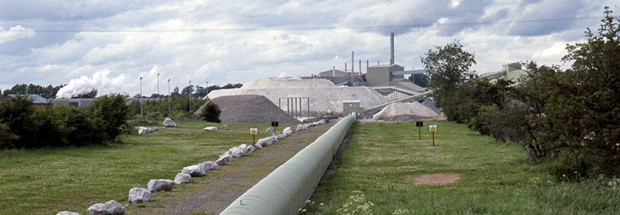by Graham Brooks
Gypsum is the naturally occurring form of Calcium Sulphate in its hydrated form (CaSO4 2H2O). The anhydrated form also occurs and is usually termed Anhydrite. These minerals occur mainly in three areas in Cumbria where they have been exploited commercially. These areas are around the village of Cotehill, just south of Carlisle, Kirkby Thore in the Eden valley and St Bees Head near Whitehaven. The only site working at present is the Kirkby Thore site.
Gypsum was originally quarried to produce whitening stones for applying to front door steps etc. But the main increase in commercial development came with the development of the plaster industry from the 1820’s onward.
The production of plaster involves crushing the gypsum and then heating it in pans to drive off the water of crystalisation. If heated to about 163oC only part of the water is driven off and Plaster of Paris is produced. If heated to above 200oC all the water is lost and a soluble anhydrite is formed. This differs from natural anhydrite because it will reabsorb water and will set as a solid mass. This is the basis of plaster.
Anhydrite was used in the chemical industry as a component in the production of Sulphuric acid. The Marchon Co at Whitehaven used the extensive deposits below their site for this purpose. Large quantities of anhydrite were quarried in the Eden valley and shipped by rail to the chemical works at Billingham.
Most of the original extraction was by quarrying this was later replaced by mining as the seams got deeper. Originally the gypsum was transported to mills in the nearby towns. But soon processing mills were built next to the mines.
The main Victorian companies involved in plaster production were:-
Joseph Robinson and Co. who had quarries at Knothill near Carlisle, Kirkby Thore and Barrowmouth at Whitehaven.
J Howe and Co worked the Cocklakes site near Carlisle.
Long Meg Plaster Co mines in the Long Meg area.
All these companies were amalgamated into the Carlisle plaster and cement co. in 1911. This was taken over by Gotham co. in 1916
Thomas McGhie and sons worked in the Kirkby Thore area also.
In the present day the remains of this industry are few. The modern plant and mines at Kirkby Thore are still working. The water filled quarries at Knothill near Carlisle are still to be seen in the forest area. The Cocklakes site has now been cleared of the buildings.
The Long Meg site still has the area of the large number of railway sidings that were used to transport anhydrite to Billingham. Also on the river bank are the remains of the early plaster mill.
At Whitehaven the site of the Barrowmouth mine is still visible.
FURTHER READING
Gypsum in Cumbria: Ian Tyler, Blue Rock Publications, 2000
A saga of British Industry: J Routley, BPB Holdings, 1959
The history of BPB Industries, D Jenkins, W J Mckay Ltd, 1973
(Page created 19/04/05. Photo added 02/11/20)

